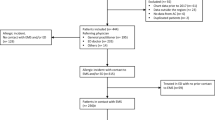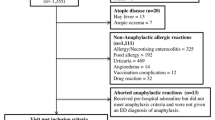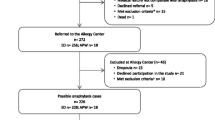Abstract
Purpose of review
The aim of this document is to review the epidemiology of anaphylaxis in the emergency departments (EDs) (burden and temporal trends), the generally deficient management of anaphylaxis in the ED, and the measures and interventions tested in different settings to improve management of anaphylaxis in the ED.
Recent findings
The population attended for anaphylaxis episodes is low (0.009 to 0.4%). Recent studies report an increase in anaphylaxis episodes attended in the ED. Discordance has been observed between the diagnosis of anaphylaxis in the ED and the diagnosis confirmed in allergy units; this can reach 45%. Management of anaphylaxis is not consistent with international guidelines, and the lack of adherence to guidelines affects the use of epinephrine in the ED, prescription of epinephrine autoinjectors, initial advice on avoidance, and referral to an allergist. Measures to improve the management of anaphylaxis have proven effective.
Summary
The low burden of anaphylaxis in the ED and the disappointing landscape of management of this syndrome in the ED should drive strategies aimed at providing staff with key concepts and measures that enable them to manage episodes of anaphylaxis effectively.
Similar content being viewed by others
References and Recommended Reading
Papers of particular interest, published recently, have been highlighted as: • Of importance •• Of major importance
Braganza SC, Acworth JP, McKinnon DRL, Peake JE, Brown AFT. Paediatric emergency department anaphylaxis: different patterns from adults. Arch Dis Child. 2006;91(2):159–63. https://doi.org/10.1136/adc.2004.069914.
Steward AG, Ewin PW. The incidence, aetiology and management of anaphylaxis presenting to an accident and emergency department. Q J Med. 1996;89:759. https://doi.org/10.1093/qjmed/89.11.859.
Klein JS, Yocum MW. Underreporting of anaphylaxis in a community emergency room. J Allergy CIin Immunol. 1995;95:637–8. https://doi.org/10.1016/s0091-6749(95)70329-2.
Poachanukoon O, Paopairochanakorn C. Incidence of anaphylaxis in the emergency department: a 1-year study in a university hospital. Asian Pac J Allergy Immunol. 2006;24(2–3):111–6.
Bellou A, Manel J, Samman-Kaakaji H, Korwin JD, Moneret-Vautrin DA, Bollaert PE, et al. Spectrum of acute allergic diseases in an emergency department: an evaluation of one year experience. Emerg Med (Fremantle). 2003;15:341–7. https://doi.org/10.1046/j.1442-2026.2003.00472.x.
Gaeta TJ, Clark S, Pelletier AJ, Camargo CA. National study of US emergency department visits for acute allergic reactions, 1993 to 2004. Ann Allergy Asthma Immunol. 2007;98:360–5. https://doi.org/10.1016/S1081-1206(10)60883-6.
Smit DV, Cameron PA, Rainer TH. Anaphylaxis presentations to an emergency department in Hong Kong: incidence and predictors of biphasic reactions. J Emerg Med. 2005;28(4):381–8. https://doi.org/10.1016/j.jemermed.2004.11.028.
Sørensen HT, Nielsen B, Østergaard Nielsen J. Anaphylactic shock occurring outside hospitals. Allergy. 1989;44:288–90. https://doi.org/10.1111/j.1398-9995.1989.tb01071.x.
Pastorello EA, Rivolta F, Bianchi M, Mauro M, Pravettoni V. Incidence of anaphylaxis in the emergency department of a general hospital in Milan. J Chromatogr B Biomed Sci Appl. 2001;756:11–7. https://doi.org/10.1016/s0378-4347(01)00067-6.
Silva L, Mehr SS, Tey D, MLK T. Paediatric anaphylaxis: a 5-year retrospective review. Allergy. 2008;63:1071–6. https://doi.org/10.1111/j.1398-9995.2008.01719.x.
Harduar-Morano L, Simon MR, Watkins S, Blackmore C. Algorithm for the diagnosis of anaphylaxis and its validation using population-based data on emergency department visits for anaphylaxis in Florida. J Allergy Clin Immunol. 2010;126:98–104. https://doi.org/10.1016/j.jaci.2010.04.017.
Moro Moro M, Tejedor Alonso MA, Esteban Hernández J, Múgica García MV, Rosado Ingelmo A, Vila AC. Incidence of anaphylaxis and subtypes of anaphylaxis in a general hospital emergency department. J Investig Allergol Clin Immunol. 2011;21(2):142–9.
• Huang F, Kirsi K, Järvinen KM, Anna Nowak-Wegrzyn A. Anaphylaxis in a New York City pediatric emergency department: triggers, treatments, and outcomes. J Allergy Clin Immunol. 2012;129:162–8. https://doi.org/10.1016/j.jaci.2011.09.018 This article combines anaphylaxis management data and an intervention to improve it.
Ronna L, Campbell RL, John B, Hagan JB, James T, Li TC, et al. Anaphylaxis in emergency department patients 50 or 65 years or older. Ann Allergy Asthma Immunol. 2011;106:401–6. https://doi.org/10.1016/j.anai.2011.01.011.
•• Harduar-Morano L, Simon MR, Watkins S, Blackmore C. A population-based epidemiologic study of emergency department for anaphylaxis in Florida. J Allergy Clin Immunol. 2011;128:594–600. https://doi.org/10.1016/j.jaci.2011.04.049 One of the studies with wider number of anaphylaxis episodes attended in the ED.
Brown AFT, McKinnon D, Chu K. Emergency department anaphylaxis: a review of 142 patients in a single year. J Allergy Clin Immunol. 2004;114:371–6. https://doi.org/10.1016/j.jaci.2004.04.029.
••Motosue M, Bellolio MF, Van Houten HK, Shah ND, Campbell RL. Increasing emergency department visits for anaphylaxis, 2005-2014. J Allergy Clin Immunol Pract. 2017;(1):171–175.e3. https://doi.org/10.1016/j.jaip.2016.08.013 A study based in a wide national database of anaphylaxis episodes attended in ED of USA.
Corriger J, Beaudouin E, Rothmann R, Penven E, Haumonte Q, Thomas H, et al. Epidemiological data of anaphylaxis in French emergency departments. J Investig Allergol Clin Immunol. 2019;29(5):357–64. https://doi.org/10.18176/jiaci.0348.
•• Arroabarren LI, Olaciregui I, Sarasqueta C, JMuñoz P-YEG. Improving anaphylaxis management in a pediatric emergency department. Pediatr Allergy Immunol. 2011;22:708–14. https://doi.org/10.1111/j.1399-3038.2011.01181.x Interventions in individual institutions can improve the management of anaphylaxis and their effectivity.
Ye YM, Ye YM, Kim MK, Kang HR, Kim TB, Sohn SW, et al. Predictors of the severity and serious outcomes of anaphylaxis in Korean adults: a multicenter retrospective case study. Allergy, Asthma Immunol Res. 2015;7(1):22–9. https://doi.org/10.4168/aair.2015.7.1.22.
• Alvarez-Perea A, Tomás-Pérez M, Martínez-Lezcano P, Marco G, Pérez D, Zubeldia JM, et al. Anaphylaxis in adolescent/adult patients treated in the emergency department: differences between initial impressions and the definitive diagnosis. J Investig Allergol Clin Immunol. 2015;25(4):288–94 Unrecognized or undiagnosed anaphylaxis episodes in an emergency department were subtreated with epinephrine.
Lacombe-Barrios J, Gómez F, Pérez N, Barrionuevo E, Doña I, Fernández Tahía D, et al. Accuracy of the diagnosis of allergic reactions in the emergency department. J Investig Allergol Clin Immunol. 2019;29(3):222–30. https://doi.org/10.18176/jiaci.0313.
Rudders SA, Banerji A, Vassallo MF, Clark S, Camargo CA Jr. Trends in pediatric emergency department visits for food-induced anaphylaxis. J Allergy Clin Immunol. 2010;126:385–8. https://doi.org/10.1016/j.jaci.2010.05.018.
Alkanhal R, Alhoshana I, Aldakhil S , Alromaih N, Alharthy N, Salam M, , Almutairi AF . Prevalence triggers and clinical severity associated with anaphylaxis at a tertiary care facility in Saudi Arabia: a cross-sectional study. Medicine (Baltimore) (2018) 97:31(e11582). DOI: https://doi.org/10.1097/MD.0000000000011582
Oropeza AR, Lassen A, Halken S, Bindslev-Jensen C, Mortz MG, et al. Anaphylaxis in an emergency care setting: a one year prospective study in children and adults. Scan J Trauma Resusc Emerg Med. 2017;25:111. https://doi.org/10.1186/s13049-017-0402-0.
Michelson K, Dribin TE, Neuman MI. Trends in emergency care for anaphylaxis. J Allergy Clin Immunol Pract. 2019. https://doi.org/10.1016/j.jaip.2019.07.018 A recent multicenter study showing an increasing trend of visits to ED due to anaphylaxis.
Tejedor-Alonso MA, Moro-Moro M, Mosquera-González M, Rodriguez-Alvarez M, Perez Fernández E, Latasa-Zamalloa P, et al. Increased incidence of admissions for anaphylaxis in Spain. 1998–2011. Allergy. 2015;70:880–3. https://doi.org/10.1111/all.12613.
Turner PJ, Gowland M, Sharma V, Ierodiakonou D, Harper N, Garcez T, et al. Increase in anaphylaxis-related hospitalizations but no increase in fatalities: an analysis of United Kingdom national anaphylaxis data, 1992–2012. J Allergy Clin Immunol. 2015;135(4):956–963.e1. https://doi.org/10.1016/j.jaci.2014.10.021.
Poulos LM, Waters A-M, Pop GD, Correll PK, Loblay RH, Marks GB. Trends in hospitalizations for anaphylaxis, angioedema, and urticaria in Australia, 1993-1994 to 2004-2005. J Allergy Clin Immunol. 2007;120:878–84. https://doi.org/10.1016/j.jaci.2007.07.040.
Ross MP, Ferguson M, Street D, Klontz K, Schroeder T, Luccioli S. Analysis of food-allergic and anaphylactic events in the National Electronic Injury Surveillance System. J Allergy Clin Immunol. 2008;121:166–71. https://doi.org/10.1016/j.jaci.2007.10.012.
Thomson H, Seith R, Craig S. Inaccurate diagnosis of paediatric anaphylaxis in three Australian emergency departments. J Paediatr Child Health. 2017;53:698–704. https://doi.org/10.1111/jpc.13483.
Demoly P, Tanno LK, Akdis CA, Lau S, Calderon MA, Santos AF, et al. Global classification and coding of hypersensitivity diseases – an EAACI–WAO survey, strategic paper and review. Allergy. 2014;69:559–70. https://doi.org/10.1111/all.12386.
•• Sclar DA, Lieberman PL. Anaphylaxis: underdiagnosed, underreported, and undertreated. Am J Med. 2014;127(1 Suppl):S1–5. https://doi.org/10.1016/j.amjmed.2013.09.007 The authors give a reliable perspective about as anaphylaxis episodes occur in real life.
World Health Organization. International classification of diseases. Geneva: World Health Organization; 2018. Available from: http://www.who.int/classifications/icd/en. [Cited 20 June 2018]. Accessed 1 Dec 2019.
Tanno LK, Bierrenbach AL, Calderon MA, et al. Decreasing the undernotification of anaphylaxis deaths in Brazil through the International Classification of Diseases (ICD)-11 revision. Allergy. 2017;72:120–5. https://doi.org/10.1111/all.13006.
Aun MV, Kalil J, Giavina-Bianchi P. Adults and children with anaphylaxis in the emergency room: why it is not recognized? Curr Opin Allergy Clin Immunol. 2018;18:377–81. https://doi.org/10.1097/ACI.0000000000000469.
De Feo G, Parente R, Triggiani M. Pitfalls in anaphylaxis. Curr Opin Allergy Clin Immunol. 2018;18:382–6. https://doi.org/10.1097/ACI.0000000000000468.
•• Campbell RL, Bellolio MF, Knutson BD, Bellamkonda VR, Fedko MG, Nestler DM, et al. Epinephrine in anaphylaxis: higher risk of cardiovascular complications and overdose after administration of intravenous bolus epinephrine compared with intramuscular epinephrine. J Allergy Clin Immunol Pract. 2015;3(1):76–80. https://doi.org/10.1016/j.jaip.2014.06.007 A necessary although redundant warming about the risks of severe adverse effects with intravenous epinephrine.
Fleming JT, Clark S, Camargo CA Jr, Rudders SA. Early treatment of food-induced anaphylaxis with epinephrine is associated with a lower risk of hospitalization. J Allergy Clin Immunol Pract. 2015;3(1):57–62. https://doi.org/10.1016/j.jaip.2014.07.004.
Bock SA, Muñoz-Furlong A, Sampson HA. Fatalities due to anaphylactic reactions to foods. J Allergy Clin Immunol. 2001;107:191–3. https://doi.org/10.1067/mai.2001.112031.
Simons FE, Ardusso LR, Bilò MB, Cardona V, Ebisawa M, El-Gamal YM, et al. International consensus on (ICON) anaphylaxis. World Allergy Organ J. 2014;7(1):9. https://doi.org/10.1186/1939-4551-7-9.
Muraro A, Roberts G, Worm M, Bilò MB, Brockow K, Fernández Rivas M, et al. Anaphylaxis: guidelines from the European Academy of Allergy and Clinical Immunology. Allergy. 2014;69(8):1026–45. https://doi.org/10.1111/all.12437.
Jeong K, Lee JD, Kang DR, Lee S. A population-based epidemiological study of anaphylaxis using national big data in Korea: trends in age-specific prevalence and epinephrine use in 2010-2014. Allergy, Asthma Clin Immunol. 2018;14:31. https://doi.org/10.1186/s13223-018-0251-z.
Cohen N, Capua T, Pivko D, Ben-Shoshan M, Benor S, Rimon A. Trends in the diagnosis and management of anaphylaxis in a tertiary care pediatric emergency department. Ann Allergy Asthma Immunol. 2018;121(3):348–52. https://doi.org/10.1016/j.anai.2018.06.033.
O'Keefe A, Clarke A, St Pierre Y, Mill J, Asai Y, Eisman H, et al. The risk of recurrent anaphylaxis. J Pediatr. 2017;180:217–21. https://doi.org/10.1016/j.jpeds.2016.09.028.
Kim MY, Park CS, Jeong JW. Management and educational status of adult anaphylaxis patients at emergency department. Korean J Intern Med. 2018;33(5):1008–15. https://doi.org/10.3904/kjim.2016.024.
Ponce Guevara LV, Laffond Yges E, Gracia Bara MT, Moreno Rodilla E, Muñoz Bellido FJ, Lázaro Sastre M, et al. Adherence to anaphylaxis guidelines: real-world data from the emergency department of a tertiary hospital. J Investig Allergol Clin Immunol. 2018;28(4):246–52. https://doi.org/10.18176/jiaci.0243.
Takazawa T, Oshima K, Saito S. Drug-induced anaphylaxis in the emergency room. Acute Med Surg. 2017;4(3):235–45. https://doi.org/10.1002/ams2.282.
Wood JP, Traub SJ, Lipinski C. Safety of epinephrine for anaphylaxis in the emergency setting. World J Emerg Med. 2013;4(4):245–51. https://doi.org/10.5847/wjem.j.1920-8642.2013.04.001.
Pulcini JM, Marshall GD Jr, Naveed A. Presence of food allergy emergency action plans in Mississippi. Ann Allergy Asthma Immunol. 2011;107(2):127–32. https://doi.org/10.1016/j.anai.2011.05.019.
Dubus JC, Lê MS, Vitte J, Minodier P, Boutin A, Carsin A, et al. Use of epinephrine in emergency department depends on anaphylaxis severity in children. Eur J Pediatr. 2019;178(1):69–75. https://doi.org/10.1007/s00431-018-3246-3.
Sheikh A, Shehata YA, Brown SG, Simons FE. Adrenaline for the treatment of anaphylaxis: Cochrane systematic review. Allergy. 2009;64:204–12. https://doi.org/10.1111/j.1398-9995.2008.01926.x.
Armstrong N, Wolff R, van Mastrigt G, Martinez N, Hernandez AV, Misso K, et al. A systematic review and cost-effectiveness analysis of specialist services and adrenaline auto-injectors in anaphylaxis. Health Technol Assess. 2013;17(17):1–117. https://doi.org/10.3310/hta17170.
Tejedor-Alonso MA, García MV, Hernández JE, Moro MM, Ezquerra PE, Ingelmo AR, et al. Recurrence of anaphylaxis in a Spanish series. J Investig Allergol Clin Immunol. 2013;23(6):383–91.
Serbes M, Can D, Atlihan F, Günay I, Asilsoy S, Altinöz S, et al. Common features of anaphylaxis in children. Allergol Immunopathol (Madr). 2013;41(4):255–60. https://doi.org/10.1016/j.aller.2012.04.011.
Banerji A, Rudders SA, Corel B. Repeat epinephrine treatments for food-related allergic reactions that present to the emergency department. Allergy Asthma Proc. 2010;31(4):308–16. https://doi.org/10.2500/aap.2010.31.3375.
Gelincik A, Demirturk M, Yilmaz E, Ertek B, Erdogdu D, Çolakoğlu B, et al. Anaphylaxis in a tertiary adult allergy clinic: a retrospective review of 516 patients. Ann Allergy Asthma Immunol. 2013;110(2):96–100. https://doi.org/10.1016/j.anai.2012.11.018.
Motosue M, Bellolio MF, Van Houten HK, Shah ND, Campbell RL. Predictors of epinephrine dispensing and allergy follow-up after emergency department visit for anaphylaxis. Ann Allergy Asthma Immunol. 2017;119(5):452–8. https://doi.org/10.1016/j.anai.2017.08.005.
Mostmans Y, Grosber M, Blykers M, Mols P, Naeije N, Gutermuth J. Adrenaline in anaphylaxis treatment and self-administration: experience from an inner city emergency department. Allergy. 2017;72(3):492–7. https://doi.org/10.1111/all.13060.
Burnell FJ, Keijzers G, Smith P. Review article: quality of follow-up care for anaphylaxis in the emergency department. Emerg Med Australas. 2015;27(5):387–93. https://doi.org/10.1111/1742-6723.12458.
Motosue MS, Bellolio MF, Van Houten HK, Shah ND, Bellamkonda VR, Nestler DM, et al. Temporal trends in epinephrine dispensing and allergy/immunology follow-up among emergency department anaphylaxis patients in the United States, 2005–2014. J Allergy Clin Immunol Pract. 2017;5(5):1272–9. https://doi.org/10.1016/j.jaip.2017.06.009.
Campbell RL, Park MA, Kueber MA Jr, Lee S, Hagan JB. Outcomes of allergy/immunology follow-up after an emergency department evaluation for anaphylaxis. J Allergy Clin Immunol Pract. 2015;3:88–93. https://doi.org/10.1016/j.jaip.2014.07.011.
Rudders SA, Banerji A, Katzman DP, Clark S, Camargo CA Jr. (Abstract). Multiple epinephrine doses for stinging insect hypersensitivity reactions treated in the emergency department. Ann Allergy Asthma Immunol. 2010;105(1):85–93. https://doi.org/10.1016/j.anai.2010.05.004.
Banerji A, Rudders S, Clark S, Wei W, Long AA, Camargo CA Jr. Retrospective study of drug-induced anaphylaxis treated in the emergency department or hospital: patient characteristics, management, and 1-year follow-up. J Allergy Clin Immunol Pract. 2014;2(1):46–51. https://doi.org/10.1016/j.jaip.2013.08.012.
Manivannan V, Hess EP, Bellamkonda VR, Nestler DM, Bellolio MF, Hagan JB, et al. A multifaceted intervention for patients with anaphylaxis increases epinephrine use in adult emergency department. J Allergy Clin Immunol Pract. 2014;2:294–9. https://doi.org/10.1016/j.jaip.2013.11.009.
Choi YJ, Kim J, Jung JY, Kwon H, Park JW. Underuse of epinephrine for pediatric anaphylaxis victims in the emergency department: a population-based study. Allergy, Asthma Immunol Res. 2019;11(4):529–37. https://doi.org/10.4168/aair.2019.11.4.529.
Tritt A, Gabrielli S, Zahabi S, Clarke A, Moisan J, Eisman H, et al. Short- and long-term management of cases of venom-induced anaphylaxis is suboptimal. Ann Allergy Asthma Immunol. 2018;121(2):229–234.e1. https://doi.org/10.1016/j.anai.2018.04.006.
Castilano A, Sternard B, Cummings ED, Shi R, Arnold T, Bahna SL. Pitfalls in anaphylaxis diagnosis and management at a university emergency department. Allergy Asthma Proc. 2018;39(4):316–21. https://doi.org/10.2500/aap.2018.39.4144.
Gabrielli S, Clarke AE, Eisman H, Morris J, Joseph L, La Vieille S, et al. Disparities in rate, triggers, and management in pediatric and adult cases of suspected drug-induced anaphylaxis in Canada. Immun Inflamm Dis. 2018;6(1):3–12. https://doi.org/10.1002/iid3.201.
Jongco AM, Bina S, Sporter RJ, Cavuoto Petrizzo MA, Kaplan B, Kline M, et al. A simple allergist-led intervention improves resident training in anaphylaxis. J Allergy (Cairo). 2016;2016:9040319. https://doi.org/10.1155/2016/9040319.
•• Rueter K, Ta B, Bear N, Lucas M, Borland ML, Prescott SL. Increased use of adrenaline in the management of childhood anaphylaxis over the last decade. J Allergy Clin Immunol Pract. 2018;6(5):1545–52. https://doi.org/10.1016/j.jaip.2017.11.038 Epinephrine is increasingly used for treatment of anaphylaxis in several European countries. Have national and international campaigns promoting better management of anaphylaxis proven successful?
Author information
Authors and Affiliations
Corresponding author
Ethics declarations
Conflict of Interest
Ana Rosado declares that she has no conflict of interest. Maria Moro-Moro declares that she has no conflict of interest. Ana Gonzalez-Moreno declares that she has no conflict of interest. Teresa Alfaya-Arias declares that she has no conflict of interest. Nuria Alberti-Masgrau declares that he has no conflict of interest. Miguel Tejedor-Alonso declares that he has no conflict of interest.
Human and Animal Rights and Informed Consent
This article does not contain any studies with human or animal subjects performed by any of the authors.
Additional information
Publisher’s Note
Springer Nature remains neutral with regard to jurisdictional claims in published maps and institutional affiliations.
This article is part of the Topical Collection on Drug Allergy
Rights and permissions
About this article
Cite this article
Rosado, A., Moro-Moro, M., Gonzalez-Moreno, A. et al. Anaphylaxis Attended in Emergency Departments: a Reliable Picture of Real-world Anaphylaxis. Curr Treat Options Allergy 7, 165–180 (2020). https://doi.org/10.1007/s40521-020-00252-0
Published:
Issue Date:
DOI: https://doi.org/10.1007/s40521-020-00252-0




